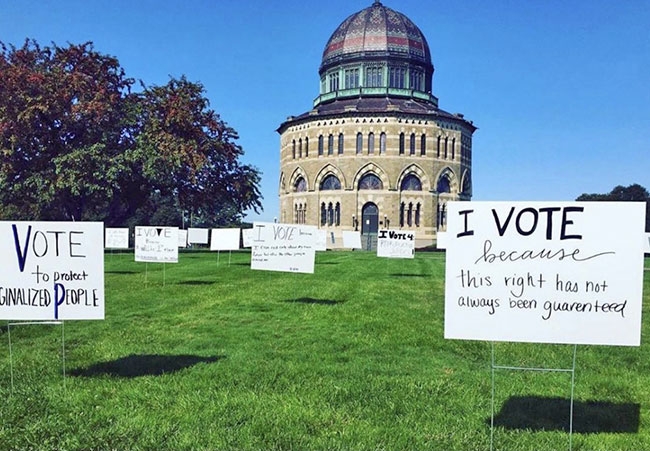Voting by Union students increased significantly in last year’s presidential election, jumping more than 27 percentage points in 2020 compared to the 2016 election, according to a new report from the Institute for Democracy & Higher Education.
Sixty-eight percent of eligible students at Union voted in the hotly contested race between Republican incumbent Donald Trump and Democratic challenger Joe Biden. That’s two percentage points higher than the record 66 percent of college students nationally who voted, according to the study by the institute, creators of the National Study of Learning, Voting, and Engagement. The institute is located at Tufts University’s Tisch College of Civic Life.
Union’s student rate was slightly higher than the national rate of 67 percent for all voters in 2020, as calculated by the U.S. Census Bureau.
In 2016, 41 percent of eligible students at Union voted in the race between Trump and Hillary Clinton. Nationally, the college student voter turnout was 52 percent.
The College’s huge spike in student voting in the 2020 election was part of a deliberate effort to get students engaged.
A joint plan between Academic Affairs and Student Affairs, the nonpartisan Civic Engagement Initiative was focused on voter education, voter registration and voter participation during the election season.
The 11-member committee was made up of students, faculty and staff. Co-chairs were Lauren Dougherty, director of Student Activities, and Robyn Reed, head of access services and associate librarian for Schaffer Library.
The initiative kicked off pre-pandemic with a discussion on the impeachment hearings against President Trump. Collaborating with other groups on campus such as Black Student Union and Women’s Union, the initiative sponsored a series of popular virtual debate watch parties featuring expert commentary from professors and covered the cost of postage for students to mail in absentee ballots. There was also a voter registration awareness campaign in which students, faculty and staff completed the statement, “I Vote Because…” on lawn signs that were displayed in front of the library.
The initiative also sponsored a number of other activities.
While the goal was to increase student voter participation in the election, the initiative was personal to some.
“For me, it's about having a voice in this so-called representative democracy and exercising a right that was denied so many of my ancestors,” said Reed. “I am a Black American woman. In the past, you could not be any more disenfranchised than that. Voting is my birthright, hard fought and won. If I do not vote, it is as if those who struggled and even died for this right did so for nothing. I cannot let that sacrifice go unacknowledged by not showing up.”
The 2020 election was the first opportunity for Michelle Moina ’22 to participate in a presidential contest. An interdepartmental major in psychology and studio arts, Moina said it was critical to exercise her right to vote. She went home to New York City to cast her ballot on Election Day.
“As a female and a woman of color, I was excited to take a stance against the negative and derogatory rhetoric of Trump,” said Moina.
The record high student voter rates at Union mirrored the picture nationally in the survey of voter records of nearly 1,200 campuses, which includes private and public institutions and community colleges.
“That students, often younger and first-time voters, turned out at rates commensurate with the general public is nothing short of stunning,” said IDHE Director Nancy Thomas. “We attribute this high level of participation to many factors, including student activism on issues such as racial injustice, global climate change and voter suppression, as well as increased efforts by educators to reach students and connect them to the issues and to voting resources.”
